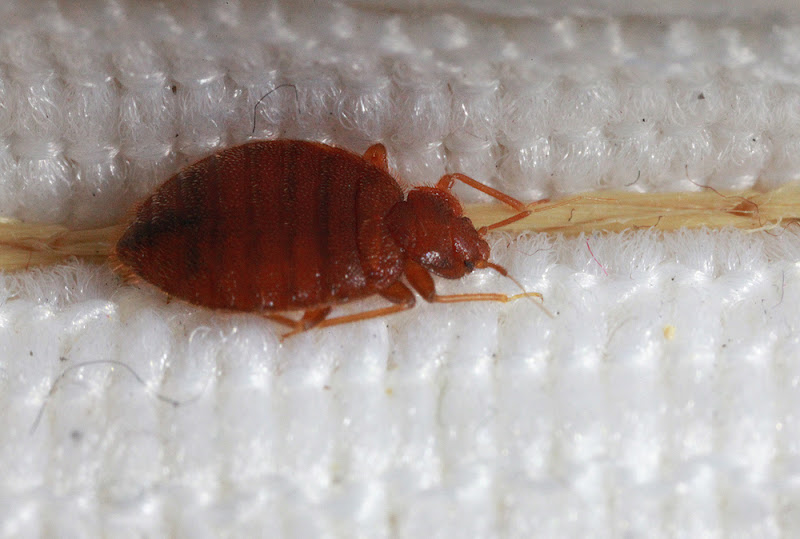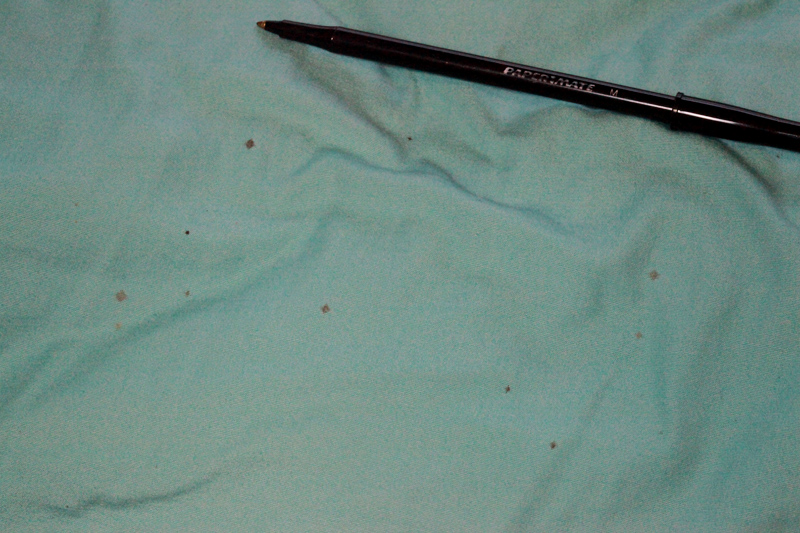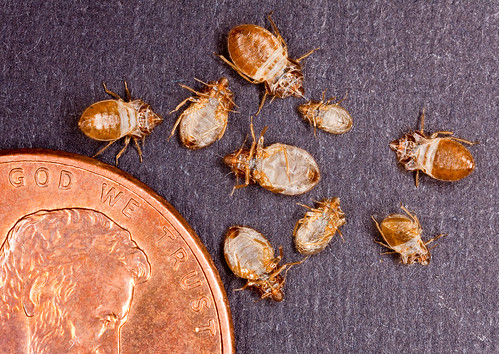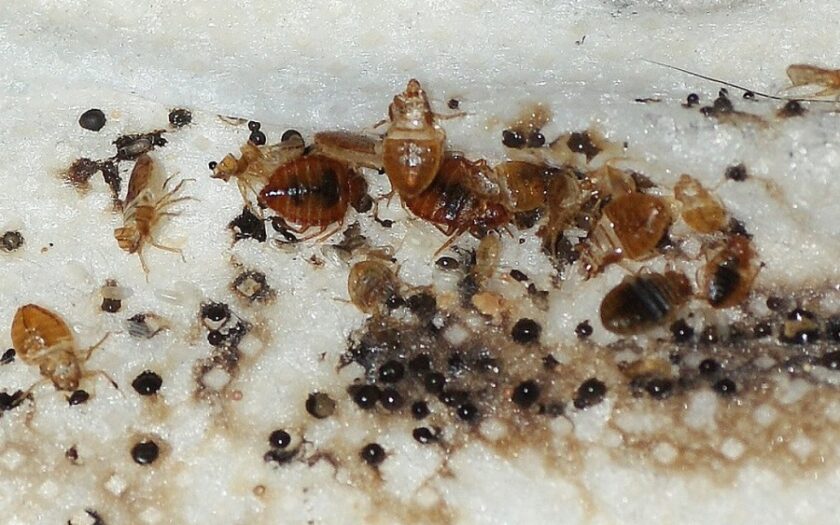Bites are usually one of the first symptoms of bed bugs that people notice. However, bites alone are not sufficient evidence to conclude that bed bugs are present. Not to mention that by the time you notice the bite symptoms, there may already be more than one generation of bedbugs living under your roof. Here you’ll learn the signs of a bed bug infestation, see pictures of what they look like and learn how to control them.
What are bed bugs?

Bed bugs are small, flat parasites of only about five millimeters in size that feed on the blood of humans and other warm-blooded animals. They are typically reddish-brown in color and about the size of an apple seed. They are most active at night, and they can be found in a variety of environments, including homes, hotels, and other buildings. Bed bugs are known for their ability to hide in small cracks and crevices, making them difficult to detect and eliminate. They are also capable of traveling long distances on clothing, furniture, and other objects, which can make them difficult to control.
At night, bed bugs crawl over sleeping people and feed on their blood. The bites are sometimes itchy and can become infected. Bed bugs do not, however, transmit disease. From egg to adult, bed bugs go through six stages of development. They need a blood meal every three to five days. They can reproduce and spread very quickly.
Bed bugs are not only found at a place of poor hygiene. These parasites can also be found in even the most well-kept living spaces, if they are accidentally brought in stowaways in suitcases, for example. However, a clean and tidy living environment makes it easier to identify and target the invaders.
Common Signs Bed Bugs Leave Behind
1. Feces and Fecal Stains
When bed bugs take a blood meal, they defecate (poo) almost immediately. That just adds insult to injury if you ask me! The stains left behind are often one of the first physical signs of bed bugs you will see.
Bed bug excrement leave behind black stains that resemble a smear made by a felt-tip marker. It is common for the stain to “bleed” into the cloth, giving the appearance that you went to bed with an open sharpie pen.
If you have bed bugs, you could see stains like this on your pillow case, sheets, or even on the mattress itself when you are inspecting it.
When the bed bugs are not busy feeding, they hide in harborages, and those harborages are often surrounded by areas with faeces stains or genuine droppings.
2. Blood smears and stains
Blood stains can also appear on a sheet or mattress. These stains are the result of crushed (blood-filled) bed bugs. This usually happens when you roll over while feeding and they get caught between you and the bed.

These types of bed bugs are usually found on the bedding or pillowcases themselves. Occasionally, you may also find these spots on your pajamas.
The more restlessly you sleep, the more likely you are to find this bed bug symptom in your bed.
Note: As with bed bugs, blood stains alone are not enough to tell if you have bed bugs in your bed. They are only one piece of the puzzle.
3. Shed/Cast Bed Bug Skins

As baby bed bugs (nymphs) advance toward becoming adults, they shed their skin. They do this once at each successive developmental stage, for a total of five times, until attaining. Cast skins have the appearance of lighter-colored bed bug casings or shells, which is appropriate given that this is essentially what they are. This image of cast skins from bed bugs contains skins that have been shed at various phases of the life cycle of bed bugs. You can get a very decent idea of how big they are if you compare them to a coin.
In contrast to faeces and blood stains, which are more likely to be found out in the open, they are more likely to be found in and around bed bug harborages (bed bug hideouts).
4. Eggshells
Empty eggshells are certainly a sign of a growing multi-generational bed bug population. They are very small – about 1 mm long – but visible to the naked eye – a magnifying glass helps.
They look like the dried eggshells of live bed bug eggs (see the close-up of bed bug eggs below), but are less shiny and may be a little flattened. They can be discovered in the areas where bed bugs hide, particularly on rough surfaces such as cloth or wood.

Recognising bed bug bites
Bed bug bites can manifest themselves differently from person to person. Some people have almost no reaction at all to the bites, while others have to deal with intense itching or even serious allergic reactions to the bites. However, the following is true for all of the bites that were caused by the bed bugs.
- The bites are usually not painful, maybe itchy. Interestingly, this is due to the anaesthetic secreted when the bed bug bites. You do not realise you have been bitten until much later, when bed bugs have already covered all the sheets for a long time.
- You’ll know you’ve been bitten when the skin around the bite gets red and rounded. Depending on how sensitive the skin is, in addition to the redness, there may also be some swelling, and pustules may develop.
- Since bed bugs rarely hit a blood vessel on the first bite, you may get a second, third or fourth bite in quick succession in the immediate vicinity of the first bite. This is the so-called bed bug pathway and is a clear indication of a bed bug infestation.
- Bed bugs are nocturnal insects that often feed on exposed areas of the body, such as the arms, legs, feet, neck, shoulders, and face. They do not bite through clothing.
Signs of Active Bed Bug Infestation
Even if none of the aforementioned signs of bed bugs are definitive evidence of a currently ongoing infestation, bed bugs don’t go away on their own. Therefore, you should consider them to be definite signs that they are present, but you shouldn’t stop there. In order to verify that you have a bed bug infestation, you need to find some live bed bugs.
5. Bed Bug Eggs
Bed bug eggs are shiny, transparent to pearly white and found both in bed bug nest hiding places and in places away from the main population (female bed bugs tend to lay a few eggs “away from the crowd”). They have a sticky membrane when first laid to help them stick to surfaces, and this can give them a kind of shiny appearance. Eggs of bedbugs are about 1 mm long. They are more common on wood and fabric than on plastic or metal.
6. Nymphs

Baby bed bugs, called nymphs, are smaller and lighter colored than adults. They can be almost clear until they are fed at which point they turn blood red.
At birth, they are approximately the size of a pinhead or the size of a poppy seed, and by the time they reach maturity, they are about an inch long. Their size varies depending on the developmental stage.
As a result of their tendency to eat more frequently than adults, nymphs are typically the first living bugs that are discovered. This can happen as frequently as once every day.
7. Adult Bed Bugs

Fully developed bed bugs are rusty brown in colour and very flat – until they fill their stomachs with blood. They are about ¼ inch long – about the size and shape of a small apple. As they feed on human, they swell (become more abundant) and elongate, turning a dark purple colour.
In the early stages of an infestation, you are most likely to discover them in the cracks and crevices of the headboard and bed frame, as well as around the seams, piping, and tufts of your mattress and box spring. You may also find them in the tufts of your mattress.
As time passes and the infestation grows, they tend to spread out from the immediate feeding area. Because they are so flat, they can hide in the most surprising places.
8. Distinctive Odour
Some individuals have described the odor of bed bugs as being similar to that of coriander, almonds, or nearly overripe raspberries. Bed bugs have a sweet, musty fragrance. My impression is that it has a somewhat unpleasant, sickeningly sweet odour, and I’d say it’s closer to the description of decaying raspberry than anything else. When there are larger numbers of insects present or when the insects have grown agitated, the odour is more noticeable.
Bed bug sniffing dogs are able to efficiently locate bed insect hiding places even when visual evidence is difficult to locate because of the characteristic odour that bed bugs give off. However, smelling them is not a reliable method for determining whether or not there is an infestation of bed bugs.
If You Think You Might Have Bed Bugs…
It’s time to get down to business and do your own inspection. It will take a little time and effort, but it’s not as hard as you might think.
